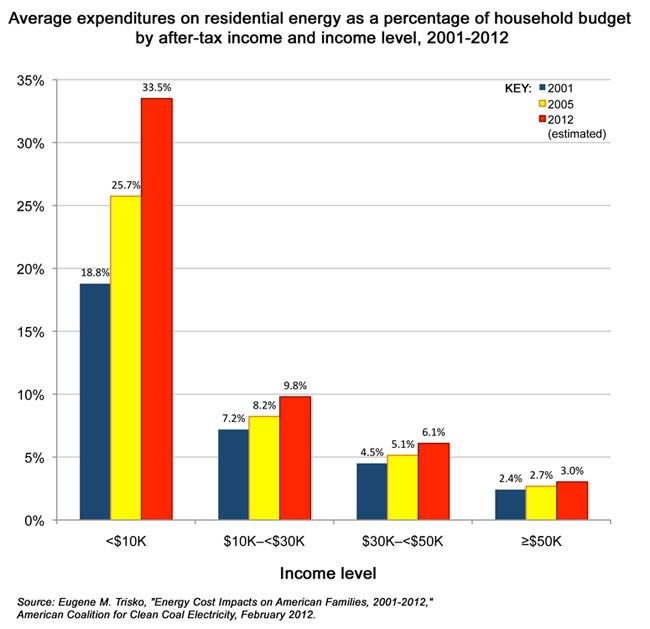Publisher's note: The author of this post is Jon Sanders, who is Director of Regulatory Studies for the John Locke Foundation.
Electricity is one of the
most basic household necessities. It isn't a luxury item.
That means it is something that every household must buy, regardless of income level — and as such, its costs are especially burdensome on the poor.
According to
Harvard University's Joint Center for Housing Studies,
For low-income households in particular, utilities account for a substantial share of overall housing costs. In 2011, utility costs were nearly a fifth (18 percent) of housing costs for the median renter earning less than $15,000 annually. Even for those earning $15,000-29,999, utility costs typically made up 16 percent of housing costs.
'Do I stay warm or eat?'
Because electricity is a basic need, as household budgets shrink, the share it takes grows. Anything that increases electricity rates (and electricity rates have been increasing) makes that burden even larger:
Perhaps those percentages sound extreme for the lower income levels. Consider also that housing options for the poor are not always as well-built, insulated, and energy-efficient as upper-income housing.
For example: Last week
WRAL spoke with poor people in Wilson, whose residents pay
higher rates than most others in the state. Still, even
lowering these bills by 10-15 percent as hoped for under
Senate Bill 305 would result in a huge monthly expense:
"It costs me an arm and a leg — and somebody else's body parts, too. It's a lot," said Shannon Taylor, an unemployed mother of three. "If I didn't use any heat, my bill was still like $600 or $700. That's like triple my rent."
Retiree Gary Nevins, 72, pays $316 a month for electricity in his 1,000-square-foot apartment.
"Do I stay warm or eat?" Nevins said of the dilemma he often faced. "That's a big choice."
Eddie Hopkins, a veteran on disability, said his March bill was $849.
"Honestly, who uses that much electricity in a month's time?" Hopkins asked. "All of us are not making the same mistakes. All of us are not intentionally running our light bills up."
The poor have as much a need of electricity as everyone else. But because they cannot afford to be as energy-efficient as wealthier families, they end up requiring disproportionately more electricity for heating, cooling, cooking, etc.
Wealthy lobbies shine brighter than the overshadowed poor
It is important for lawmakers to keep these facts in mind. They will hear
slick presentations from well-heeled green energy lobbies that try to get them to think of electricity generation as a jobs program, to support
incentives and purchase mandates that are said to "grow jobs" but which
deliberately avoid or obfuscate the price effects of these policies.
Legislators would be wise to remember the
Four P's of Electricity Competition:
- The first P is Prices — what electricity costs at the flip of the switch.
- The second is electricity prices' effect on the Poor.
- The third is what People want in electricity, which polls on both sides of the aisle show is first of all, more affordable electricity.
- The fourth is competitive Pressure, which involves both downward pressure on electricity prices as well as consumer freedom of choice, including more renewable energy by some who could afford the choice.
North Carolina's electricity rates are headed upward, in part because of the renewable portfolio standards (RPS) mandate. "Jobs" or not,
renewable energy is simply
not cost-competitive with established sources.
Case in point: Duke Energy is right now requesting to pay 15 percent less for solar energy because of
falling prices for natural gas. (They pay solar companies for the "avoided cost" of buying or generating energy on their own.)
The state RPS mandate's effects on prices have been held relatively in check, however,
because of the cost caps. Research
reiterates that increases in the RPS requirements in the very near future will run afoul of those cost caps. The wealthy green-energy lobby will then turn its attention to eliminating the cost caps.
Then as now, poor ratepayers will need their representatives to represent them.
























